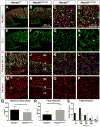Abnormal labyrinthine zone in the Hectd1-null placenta
- PMID: 26907377
- PMCID: PMC4768308
- DOI: 10.1016/j.placenta.2015.12.002
Abnormal labyrinthine zone in the Hectd1-null placenta
Abstract
Introduction: The labyrinthine zone of the placenta is where exchange of nutrients and waste occurs between maternal and fetal circulations. Proper development of the placental labyrinth is essential for successful growth of the developing fetus and abnormalities in placental development are associated with intrauterine growth restriction (IUGR), preeclampsia and fetal demise. Our previous studies demonstrate that Hectd1 is essential for development of the junctional and labyrinthine zones of the placenta. Here we further characterize labyrinthine zone defects in the Hectd1 mutant placenta.
Methods: The structure of the mutant placenta was compared to wildtype littermates using histological methods. The expression of cell type specific markers was examined by immunohistochemistry and in situ hybridization.
Results: Hectd1 is expressed in the labyrinthine zone throughout development and the protein is enriched in syncytiotrophoblast layer type I cells (SynT-I) and Sinusoidal Trophoblast Giant cells (S-TGCs) in the mature placenta. Mutation of Hectd1 results in pale placentas with frequent hemorrhages along with gross abnormalities in the structure of the labyrinthine zone including a smaller overall volume and a poorly elaborated fetal vasculature that contain fewer fetal blood cells. Examination of molecular markers of labyrinthine trophoblast cell types reveals increased Dlx3 positive cells and Syna positive SynT-I cells, along with decreased Hand1 and Ctsq positive sinusoidal trophoblast giant cells (S-TGCs).
Discussion: Together these defects indicate that Hectd1 is required for development of the labyrinthine zonethe mouse placenta.
Keywords: HECT E3 ligase; Labyrinthine layer; Placenta.
Copyright © 2015 Elsevier Ltd. All rights reserved.
Figures






Similar articles
-
Hectd1 is required for development of the junctional zone of the placenta.Dev Biol. 2014 Aug 15;392(2):368-80. doi: 10.1016/j.ydbio.2014.05.007. Epub 2014 May 20. Dev Biol. 2014. PMID: 24855001 Free PMC article.
-
Sirtuin1 is required for proper trophoblast differentiation and placental development in mice.Placenta. 2018 Feb;62:1-8. doi: 10.1016/j.placenta.2017.12.002. Epub 2017 Dec 7. Placenta. 2018. PMID: 29405961 Free PMC article.
-
Extraembryonic heparin-binding epidermal growth factor-like growth factor deficiency compromises placentation in mice.Biol Reprod. 2019 Jan 1;100(1):217-226. doi: 10.1093/biolre/ioy174. Biol Reprod. 2019. PMID: 30084919 Free PMC article.
-
Development and function of trophoblast giant cells in the rodent placenta.Int J Dev Biol. 2010;54(2-3):341-54. doi: 10.1387/ijdb.082768dh. Int J Dev Biol. 2010. PMID: 19876834 Review.
-
Regulators involved in trophoblast syncytialization in the placenta of intrauterine growth restriction.Front Endocrinol (Lausanne). 2023 Jan 31;14:1107182. doi: 10.3389/fendo.2023.1107182. eCollection 2023. Front Endocrinol (Lausanne). 2023. PMID: 36798658 Free PMC article. Review.
Cited by
-
Ubiquitin ligases: guardians of mammalian development.Nat Rev Mol Cell Biol. 2022 May;23(5):350-367. doi: 10.1038/s41580-021-00448-5. Epub 2022 Jan 25. Nat Rev Mol Cell Biol. 2022. PMID: 35079164 Review.
-
Mechanistic Insight into Long Noncoding RNAs and the Placenta.Int J Mol Sci. 2017 Jun 27;18(7):1371. doi: 10.3390/ijms18071371. Int J Mol Sci. 2017. PMID: 28653993 Free PMC article. Review.
-
Cannabidiol Exposure During Rat Pregnancy Leads to Labyrinth-Specific Vascular Defects in the Placenta and Reduced Fetal Growth.Cannabis Cannabinoid Res. 2024 Jun;9(3):766-780. doi: 10.1089/can.2023.0166. Epub 2024 Feb 16. Cannabis Cannabinoid Res. 2024. PMID: 38364116 Free PMC article.
-
Sequence variants in HECTD1 result in a variable neurodevelopmental disorder.Am J Hum Genet. 2025 Mar 6;112(3):537-553. doi: 10.1016/j.ajhg.2025.01.001. Epub 2025 Jan 28. Am J Hum Genet. 2025. PMID: 39879987 Free PMC article.
-
The ubiquitin ligase HECTD1 promotes retinoic acid signaling required for development of the aortic arch.Dis Model Mech. 2019 Jan 11;12(1):dmm036491. doi: 10.1242/dmm.036491. Dis Model Mech. 2019. PMID: 30578278 Free PMC article.
References
-
- Cross JC, Nakano H, Natale DR, Simmons DG, Watson ED. Branching morphogenesis during development of placental villi. Differentiation; research in biological diversity. 2006;74(7):393–401. - PubMed
-
- Nagy A. Manipulating the mouse embryo : a laboratory manual 2003. Cold Spring Harbor, N.Y: Cold Spring Harbor Laboratory Press; p. x.p. 764.
Publication types
MeSH terms
Substances
Grants and funding
LinkOut - more resources
Full Text Sources
Other Literature Sources
Molecular Biology Databases

